I wanted to make a short post on today’s US spy satellites, but I realized that to speculate about them, it’s better to have some historical perspective. So I assembled a condensed history of the US reconnaissance system (only for imagery, the electronic side is covered in History of the US high-altitude SIGINT system). I used Susan D. Schultz’s chronology in Why Gambit and Hexagon? U.S. National Security and the Geopolitical Setting, 1957–1960 as a starting point, and expanded it with more technical information on the reconnaissance systems, and with relevant events up to the present day. I removed quite a bit of it, so if you want more detail on the geopolitical setting of the 50s, 60s and 70s I encourage you to read at least the chronology in the link.
So here is a timeline of the US strategic reconnaissance system, from 1947 to today:
1946
The RAND Corporation delivers to the Air Force a report concluding that artificial satellites are feasible in the near term.
1947
The Central Intelligence Agency (CIA) is created.
1948
Stalin blockades all ground access to West Berlin. The US respond by airlifting supplies to the city.
1949
• The People’s Republic of China is founded.
• The USSR successfully tests its first atomic bomb.
• The US uses peripheral flights to monitor the borders and coasts of the Warsaw Pact, but is almost blind to what happens deep inside its territory.
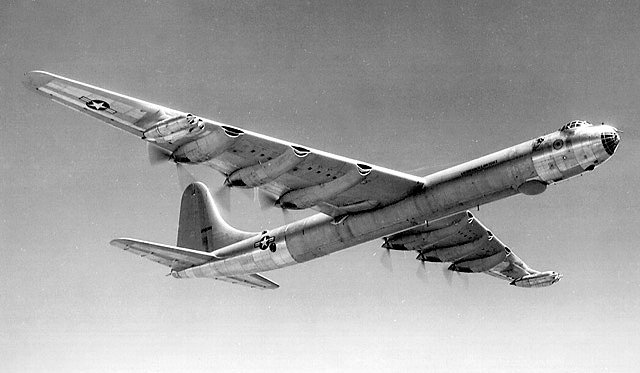
1950
Beginning of the Korean War.
1953
End of the Korean War, Korea is split in two.
1954
After several preliminary studies, the RAND corporation delivers a feasibility study on a reconnaissance satellite that would carry a television camera in orbit and radio its images back to the ground. The Air Force uses that report to start a reconnaissance satellite project, the WS-117L program.
1955
• The Soviets reject President Eisenhower’s ‘Open Skies’ proposal, which would have allowed the two superpowers to monitor each other using specific reconnaissance flights.
• The Soviets display a flight of their new Bison bomber at an air show, to the surprise of the USA. US intelligence mistakenly concludes the bomber is in mass production and warns of a bomber gap. The Air Force successfully argues for expanding its bomber program in return.
1956
• First launch of air balloons carrying cameras over the USSR. The project ends in February due to Soviet protests.
• First reconnaissance flights of the U-2 Dragon Lady spy plane over the USSR.
• The USSR invades Hungary.
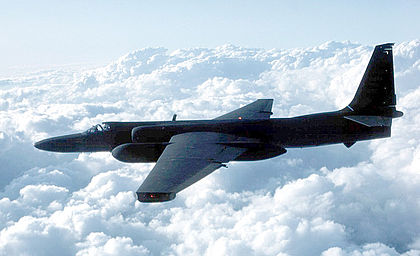
1957
• U-2 overflights of Soviet bomber bases demonstrate the Soviet bomber fleet is much smaller than previously thought, putting an end the idea of a bomber gap.
• The USSR launches into orbit Sputnik, the first artificial satellite. This shocks the American public opinion, as it demonstrates the USSR is ahead of the USA in rocket technology. As rockets can be used to deliver nuclear bombs, it creates in the US the fear of a missile gap: the USSR could have a large number of ballistic missiles (ICBM) soon, and use it to wipe out the USA in a surprise attack.
• Consequently, the USA needs to gather intelligence on the Soviet rocket program. Since the efforts up to that date have only produced vague, unreliable intelligence, a very high priority is given to the satellite reconnaissance program. The WS-117L program is reorganized. It is split into 3 components: the high-priority television reconnaissance program, a lower-priority film-return reconnaissance program and a missile-warning program. The film return component, which is the most promising in the short term, is put under CIA management. The plan is to use it as stopgap measure until the television system in ready.
• The US ICBM program is also given a boost, to try to balance the Soviet perceived advantage.
1958
Explorer I, the first US satellite, reaches orbit.
1960
• First successful image return from a film satellite: after many failed attempts, the film capsule of a KH-1 Corona is successfully retrieved. Corona satellites carry a camera that captures images on film, which is then placed in a reentry capsule. The capsule is separated from the satellite, reenters the atmosphere, and is recovered mid-air by Air Force planes. The satellite reenters separately and is destroyed in the process. The first Coronas have a medium resolution, in the order of 8m (25 feet). However, the first successful flight brings back more imagery than all the U-2 flights combined. As a result, the Corona images allow the USA to conclude there is indeed a missile gap, but in the other way around: the American missiles vastly outnumber the Soviet ones. In general, US intelligence reports become much more accurate and reliable, thanks to Corona.
• The KH-1 is quickly replaced by the KH-2 and then KH-3, also codenamed Corona. The KH-1 is the offspring of the CIA program satellite program; it is designed by the Itek Corporation and integrated by Lockheed.
• An U-2, flown by Gary Powers, is shot down over the Soviet Union. The pilot is captured by the Soviets. Overflights of the Soviet block are terminated, although the plane will still overfly other countries.
1961
• The USA steps up its involvement in the Vietnam War.
• The Defense Intelligence Agency (DIA) is founded. As a Department of Defense agency, it focuses on military intelligence.
• The National Reconnaissance Office (NRO) is founded. Its mission is to oversee the development of the US reconnaissance program, and federate the efforts of the various military branches (Air Force, Navy, Army) and intelligence agencies (CIA, NSA, DIA). The early years of the NRO are marked with prolonged bureaucratic fighting between the Air Force and the CIA.
• The National Photographic Interpretation Center (NPIC) is founded. It regroups the CIA and military image interpreters under the same roof.
• First flight of a Samos E-1 satellite. The Samos program is managed by the Air Force and comprises several variants. The E-1 is a film readout system: the camera records an image on film, and then this film is developed while in orbit, scanned by an electronic system and the data is downlinked back to the ground. This makes the images available quickly, but severely reduces the number of images that the system provides, due to the limitations of the electronics. Resolution is 30m, improved to 6m in the E-2 model, but the coverage is limited. As a result, Samos is much less useful than Corona, and the stopgap Corona program becomes the backbone of US intelligence instead of Samos.
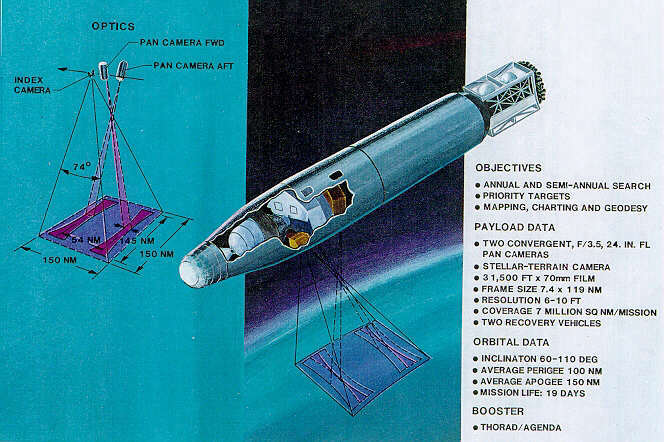
1962
• Cuban Missile Crisis. After discovering the USSR has installed intermediate range missiles in Cuba, the US blockades the island. A few days of extreme tension ensue, bringing the world at the edge of nuclear war, before the USSR agrees to withdraw the missiles (and the US withdraws missiles from Turkey).
• First launch of the KH-4 (still codenamed Corona). Compared the previous Corona modes, it carries two cameras, to take stereoscopic (3D) views of targets.
• First successful mission of a KH-5 Argon. The KH-5 is derived from the Samos E-4, and is used to make maps. The low resolution (140m) is compensated by the wide swath (550km). Only 6 successful missions will be carried out.
• First and last operational launch of a Samos E-5 film return satellite. The mission is a failure and no film is recovered. The camera, which comes down along with the film, is lost too.
• First launch of a DMSP (Defense Meteorological Satellite Program) weather satellite. One of the uses of the DMSP is to gather up-to-date cloud coverage information over the USSR, which is then used to avoid photographing overcast areas with the film reconnaissance satellites. It is important as the film supply is limited, and shooting clouds wastes the mission potential.
• Last launch of a Samos E-2.
1963
• First launch of a KH-6 Lanyard. The KH-6 was derived from Samos E-5, but out of the 3 launched only 1 successfully returned film. The resolution was around 1.8m (6 feet).
• First launch of the KH-7 Gambit 1. Gambit is higher-resolution than Corona, with a resolution of around 60cm (2 feet) but a lower coverage. It operates in tandem with it: Corona detects targets and areas of interest (it is consequently called a search system), Gambit is a surveillance system, used to precisely identify the targets, and measure their dimensions, in order to estimate the capabilities of new plane, missile or ship models. Gambit orbits between 110 and 280km, and uses 1.2m mirror. The KH-7 is designed by Eastman Kodak.
1964
• Launch of Quill, an experimental radar satellite. Images are only acquired over the US, to assess the feasibility of radar imagery.
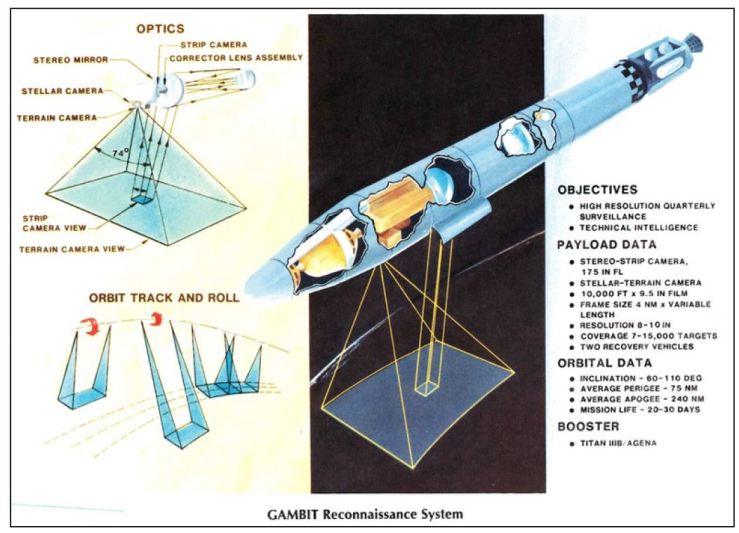
1966
• First launch of the KH-8 Gambit 3. Using a telescope of the same diameter as the KH-7, but with revamped optics and service module, the KH-8 has an extremely high resolution of reportedly up to 10 cm (4 inches). The exact resolution is still classified and as of 1984 was the highest ever achieved by satellite.
1967
• Last launch of a KH-7.
• First flight of the A-12 Oxcart spy plane over North Vietnam. The A-12 flies at Mach 3 (around 3000 km/h), at around 25 000 m (80 000 feet), and is designed to have a low radar signature. These features enable it to fly over Vietnamese SAM sites with relative degree of safety. However, the Soviet SAM sites use more advanced systems, so no overflights of the USSR are attempted.
• First operational use of a RB-57F spy plane with a direct readout infrared sensor. Previous generations recorded images on film, which could only be exploited after the aircraft had landed. The direct readout allows air crews to provided real-time intelligence, and to optimize their flight plan for more efficient collection.
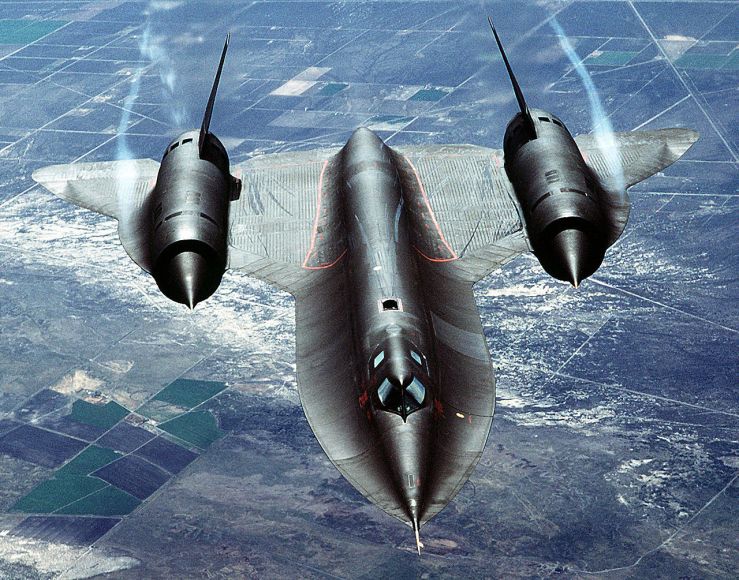
1968
• First flight of the SR-71 Blackbird spy plane over North Vietnam. The SR-71 is an evolution of the A-12, but is an Air Force-run program, whereas the A-12 was CIA. The SR-71 carries a different sensor load from the A-12, including a side-looking Synthetic Aperture Radar, able to look though clouds.
• Last flight of the A-12.
• Prague Spring: the USSR invades Czechoslovakia. The invasion is so fast that by the time the satellite imagery is available, it is already over.
1969
First flight over China of the D-21B hypersonic drone . The drone is launched from a B-52 bomber, flies at Mach 3 and records images on film. The film is then recover mid-air or at sea, like the film buckets from satellites. This first flight and the two other operational flights are failures and the program is cancelled.
The D-21A variant was supposed to be launched from a derivative of the SR-71, but was never deployed due to separation issues from the carrier plane.
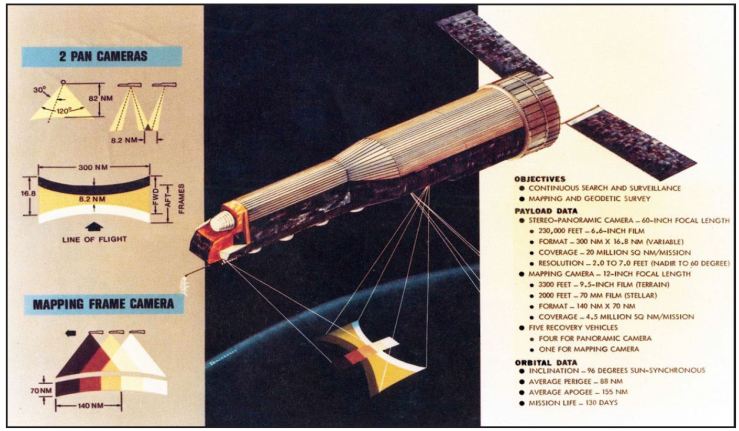
1971
Launch of the first KH-9 Hexagon. A monster of a satellite, the KH-9, nicknamed “big bird”, is a search system combining the resolution of the Gambit-1 (60cm, 2 feet) with a very large swath (550km, or 300nm, wider than the KH-4). It is a film system, with the imagery returned in 4 separate recovery capsules. The exceptional coverage of the system is used to verify that the Soviets abide by the terms of the SALT-I arms limitation treaty. Two or more satellites are launched each year, to achieve semi-annual coverage of inhabited regions of the USSR and China, and annual coverage of the rest of those countries. To do this, the KH-9 uses two 0.5m cameras, performing stereo whiskbroom scanning over a 120° angle. Mission duration could extend up to 270 days, with altitudes typically between 130 and 290 km. The KH-9 is designed by Perkin-Elmer and integrated by Lockheed. It is initially a CIA program, and is then transferred to the Air Force.
1972
• Last launch of a Corona, now replaced by the KH-9. By then the Corona series reaches model KH-4B, has seen its resolution improved to 1.8m (6 feet), and its swath reaches 280km (150nm). This was achieved using whiskbroom scan on the two cameras.
• The Defense Mapping Agency (DMA) is created.
• President Nixon announces the development of the Space Shuttle. The Shuttle is designed on the assumption that it will launch all US satellites, including NRO ones, and that the launch rate of these will keep increasing. The vehicle is consequently sized to be able to launch the KH-9 and its successors. Due to the unclassified nature of the program, NASA is not made aware that increased satellite reliability, and the move away from film systems, will drastically cut this rate in the future, and make the economics of the Shuttle untenable. To keep the manned space program going, the shuttle will also always carry a crew.
1974
NRO program D, in charge of airborne reconnaissance, is abolished. The Air Force fully takes over this responsibility.
1975
Fall of Saigon: the last US troops withdraw from Vietnam.
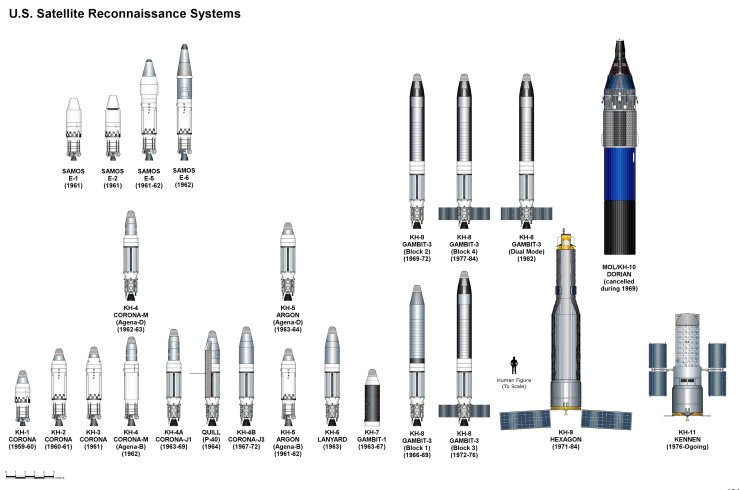
1976
• Launch of the first KH-11 Kennan, on a 300 x 500km orbit. It uses an electronic sensor instead of film, so the images can be downlinked to the ground in near real-time. These satellites have lifetimes of around 3 years, much longer than any of the film systems. In order to ensure the image downlink in near real-time, the first two data relay satellites, which form the basis of the SDS (Satellite Data System), are launched. Since the KH-11 flies higher than the Gambit, it carries a larger mirror in order to have a similar resolution. Mirror size is reported to be around 2.4m (7 feet 8 inches).
• Launches of KH-8s are reduced to 1 per year. Launches of KH-9s are also reduced to 1 per year.
1981
First launch of the Space Shuttle.
1984
• Launch of the first KH-11 block II satellite (name is speculative). Compared to the original KH-11, it orbits higher, in a 300 x 1000km orbit. These models also orbit for longer, spending up to 10 years in space.
• Last launch of a KH-8.
1986
• Last launch of a KH-9, the rocket blows up shortly after liftoff.
• Space Shuttle Challenger blows up. The long time before return to flight convinces the NRO to avoid launching payloads on the Shuttle as much as possible. This, plus another launch failure in 1985, hits the NRO hard.
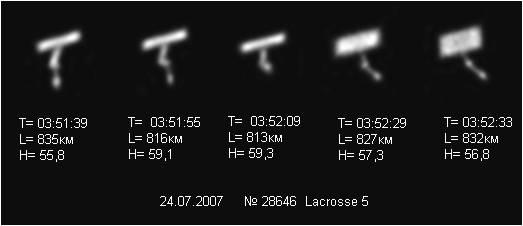
1988
First launch of a Lacrosse (later renamed Onyx) Synthetic Aperture Radar (SAR) satellite. SAR technology is very flexible, allowing high resolution or high coverage (but usually not both at the same time). It also does not depend on the Sun except for power, so it can image at night as well as during the day. The satellite is positioned to spend more time over regions of interests, compared to an optical satellite. It downlinks its data through the TDRS satellites owned by NASA.
1989
The Berlin Wall falls, much to the surprise of every intelligence agency in the world.
1990
• First Gulf War. Timely access to satellite imagery proves to be very difficult for the troops engaged. The NRO sets out to improve the delivery of tactical information to the end users.
• A mysterious payload is deployed by the Space Shuttle in a 62° orbit. Nicknamed Misty by amateur observers, it is tracked for some time but then disappears. It is presumed to be a stealthy variant of the KH-11. Two other such satellites are launched over the years.
• The SR-71 is mothballed.
1991
The USSR is dissolved. All nuclear weapons are repatriated to Russia in the following years. The Russian economy crashes, massively reducing the available military budget.
1992
The existence of the NRO is declassified.
1995
The Air Force launches the Evolved Expendable Launch Vehicle (EELV) program, to modernize its launchers and ensure a reliable access to space with the development of Atlas V and Delta IV.
1996
The NPIC, DMA, and parts of the DIA and of the NRO are merged to create the National Imagery and Mapping Agency (NIMA).
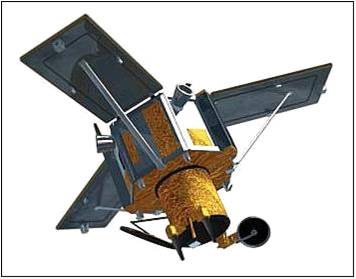
1999
• The development of the Future Imagery Architecture (FIA) is awarded to Boeing, after a competition with Lockheed. The FIA is planned to have both an optical and a radar component, to respectively replace the KH-11 and Lacrosse.
• Digital Globe, a private company, launches the Ikonos satellite. It is the first commercial satellite to collect 0.8m resolution images. Digital Globe provides commercial imagery to NIMA. Since it is not classified, it can be shared much more easily within the US government and with its allies.
2002
The Treaty on Open Skies enters into force, 47 years after the idea was proposed by President Eisenhower. It allows 34 states, including Russia and the USA, to overfly the territory of other parties with mutually agreed on optical and radar sensors, with a 72 hour warning.
2003
• Second Gulf War. Despite the tremendous capabilities of the reconnaissance program, the intelligence community finds evidence of a Weapons of Mass Destruction (WMD) program in Irak, which is used by President Bush as the basis for the invasion. The WMDs later turn out to be non-existent.
• NIMA becomes the National Geospatial-Intelligence Agency (NGA).
2005
• Launch of the 5th and last Lacrosse.
• The optical component of the FIA is cancelled after significant cost overruns and delays by Boeing. Lockheed is contracted to build two new KH-11 while the US government decides what to do next.
2008
• Geoeye, another private company, launches the Geoeye-1 satellite, capable of collecting 0.41m resolution images. Geoye is also provides imagery to the NGA.
• Using an anti-satellite missile, the USA shoots down USA-193, a NRO bird launched in 2006 which failed upon reaching orbit. The satellite was in a curious 350 km orbit with a 58° inclination, giving it only a partial view of the globe. It was presumably a test for a new type of radar satellite.
2009
After hesitating between developing lower-resolution but higher- coverage systems, and buying commercial satellites of the same class as Digital Globe and Geoeye, the US government decides to continue using KH-11s, with minimal improvements.
2010
First launch of a satellite of the radar component of the FIA (FIA-R), codenamed Topaz.
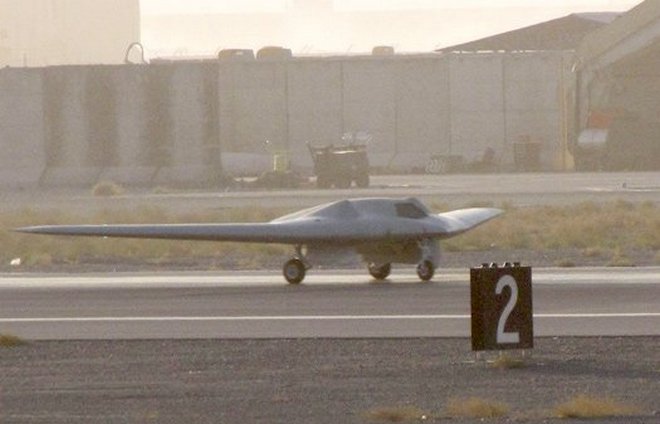
2011
• A RQ-170 stealthy reconnaissance drone crashes in Iran.
• Launch of a new generation of KH-11, the KH-11 block IV, built by Lockheed from the heritage of the pre-FIA program. Around that date, the KH-11 constellation is made up of a morning plane and an afternoon plane, each with a primary satellite and also, depending on the launches, a secondary satellite.
2012
The NRO donates two 2.4m telescopes to NASA, presumably leftovers from the FIA program.
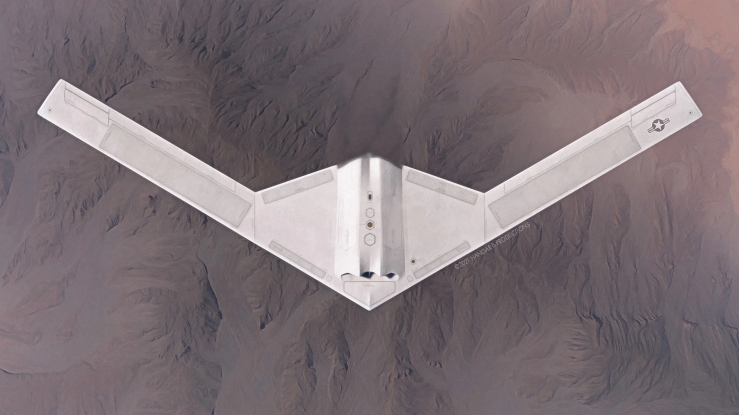
2013
• After the NGA announces it will be able to contract with only one commercial imagery provider from now on, Digital Globe buys Geoeye.
• The existence of the RQ-180 is revealed. It is a long-range, stealth reconnaissance drone, to be used to collect intelligence in hostile airspace.
2014
The first pair of Geosynchronous Space Situational Awareness Program (GSSAP) satellites is launched. They provide an up-close and frequent look at the communication, early warning and electronic intelligence satellites of other nations in the geostationary belt. The GSSAP constellation will eventually have at least 6 satellites.
2016
The NRO admits it is using cubesats for some unknown operational missions.
2017
• Test flights of a high-altitude Global Hawk drone with similar sensors to the U-2. After wanting to replace the U-2 with drones, the Air Force now plans to operate both.
•First NRO launch on a SpaceX Falcon 9 rocket.
2018
In order to replace the EELV launchers, SpaceX, ULA, Northrop Grunman and Blue Origin are awarded development money for their respective launchers.
2019
• The United States Space Force is created, as a full separate service, with a transfer of resources and personel mostly from the Air Force.
• The Space Development Agency is created, and is tasked with creating a proliferated communications, missile launch detection and tracking, and observation constellation in low Earth orbit. The last part sets up a turf war with the NRO.
2020
SpaceX, with the Falcon 9, and ULA, with Vulcan, make the final cut and are awarded the first batch of launches for the National Security Space Launch program.
2024
First launch of the NRO’s proliferated constellation in low Earth orbit, using buses derived from SpaceX’s Starlink. Sensors are provided by Northrop Grunman.
Sources
Corona
Eye in the Sky: The Story of the Corona Spy Satellites. Dwayne Day, Smithsonian History of Aviation and Spaceflight.
Samos
A sheep in wolf’s clothing: the Samos E-5 recoverable satellite. Dwayne Day, the Space Review. part I part II part III
Gambit
Ike’s gambit: The development and operations of the KH-7 and KH-8 spy satellites. Dwayne Day, the Space Review. part I part II
NRO declassified Gambit records
NRO Gambit and Hexagon History, in particular Gambit and Hexagon Histories and CRITICAL TO U.S. SECURITY: The GAMBIT and HEXAGON Satellite Reconnaissance Systems
Declassified NRO archive video on Gambit
Hexagon
The flight of the Big Bird. Dwayne Day, the Space Review. part I part II part III part IV
Meeting the Challenge: The Hexagon KH-9 Reconnaissance Satellite. Phil Pressel, AIAA.
Phil Pressel’s blog on the KH-9
NRO declassified Hexagon records
NRO Gambit and Hexagon History, in particular Gambit and Hexagon Histories and CRITICAL TO U.S. SECURITY: The GAMBIT and HEXAGON Satellite Reconnaissance Systems
Declassified NRO archive video on Hexagon
God’s eye view: HEXADOR and the very high resolution satellite Dwayne Day, the Space Review
Quill
Flight of a feather: the QUILL radar satellite Dwayne Day, the Space Review.
Spy planes & Drones
SR-71 Overview by Col. James H Shelton, Jr USAF
The Wizards Of Langley: Inside The Cia’s Directorate Of Science And Technology. Jeffrey T Richelson
Northrop Grumman Tests MS-177 Sensor on Global Hawk Bill Carey, AINOnline
Air Force Kills Retirement Date for U-2 Spy Plane Oriana Pawlyk, DoDBuzz
Secret New UAS Shows Stealth, Efficiency Advances Amy Butler & Bill Sweetman, Aviation Week
The Air Force Just Copped to Its Secret Stealth Drone David Axe, War is Boring
KH-11 & SDS
The Inside Story of How Aviation Week’s Decision to Sit on One Cold War Blockbuster Led to Another Craig Covault, AmericaSpace
Top Secret KH-11 Spysat Design Revealed By NRO’s Twin Telescope Gift to NASA Craig Covault, AmericaSpace
Intersections in real time: the decision to build the KH-11 KENNEN reconnaissance satellite Part I & II Dwayne Day, The Space Review
Gum in the Keyhole Dwayne Day, The Space Review
Relay in the Sky: The Satellite Data System Dwayne Day, Journal of the British Interplanetary Society
Spinning out of the shadows Dwayne Day, The Space Review
Shadow dancing: the Satellite Data System Dwayne Day, The Space Review
MISTY
New Spy Satellite Debated On Hill Dana Priest, The Washington Post
Lacrosse/ONYX
Radar love: the tortured history of American space radar programs Dwayne Day, The Space Review
Space Shuttle
The spooks and the turkey: Intelligence community involvement in the decision to build the Space Shuttle Dwayne Day, The Space Review
Big Black and the new bird: the NRO and the early Space Shuttle Dwayne Day, The Space Review
Between the darkness and the light Dwayne Day, The Space Review
The HEXAGON and the Space Shuttle Dwayne Day, The Space Review
Black ZEUS: The top secret shuttle mission that never flew Dwayne Day, The Space Review
Top Secret DAMON: the classified reconnaissance payload planned for the fourth space shuttle mission Dwayne Day, The Space Review


wonderful historic texte
LikeLike
[…] reconnaissance program roughly 30 years later than them. In the same way a previous post on the History of the US reconnaissance system recounted the difficult start and the successes of the American efforts, this post aims to do the […]
LikeLike
[…] an history of the high-altitude satellites which performed the collection. In the same fashion as History of the US reconnaissance system, which focused on imaging satellites, the sources we relied on are available at the end of the […]
LikeLike
[…] [To-scale drawings of the US reconnaissance satellites (credit Guiseppe De Chiara). Note the precise layout of the KH-11 is speculative – satelliteobservation.net] […]
LikeLike